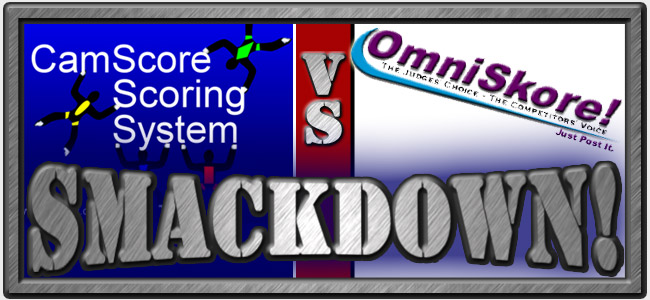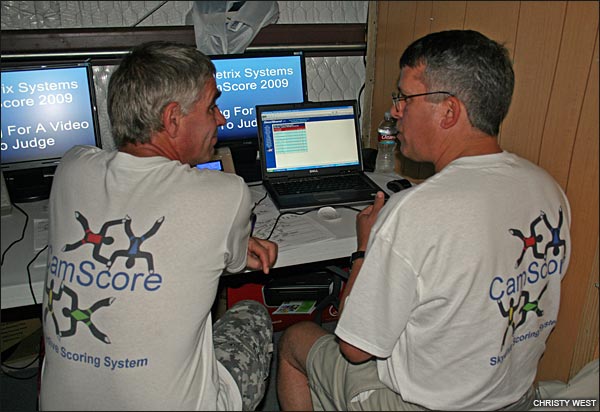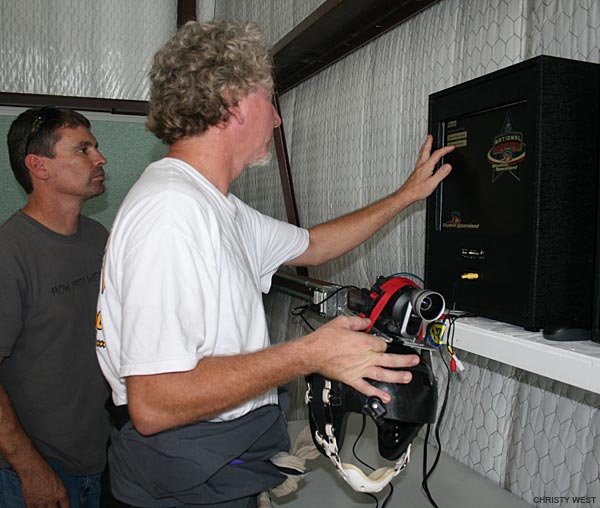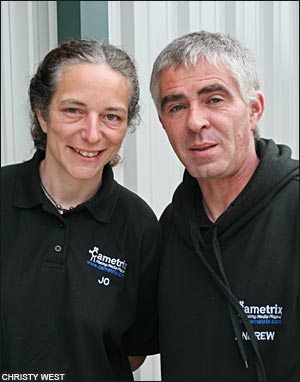Camscore vs. Omniskore
Everyone, you're in for a fantastic treat! Tim Wagner, judge extraordinaire and co-founder of the popular scoring system Omniskore, has chosen to grace us with a guest Timbit blog post! And to ice that cake, it's a post analyzing the differences between Omniskore and the CamScore Scoring System in use at this year's Nationals for the first time. (Jo, Andrew—BEER!)
Can you say…

OK, that smackdown bit is a complete joke--Tim's become a pretty big fan of CamScore, along with all the other judges here. It's been really interesting to see Tim and Andrew Mansfield of CamScore working together over the last few days to analyze the nuts and bolts of CamScore and compare the two systems in painstaking detail. (They even got to spend a few hours together on a hardware run during which the rental car broke down… but I digress.)

I think Tim said it best this morning: "I don't want to see CamScore to be as good as Omniskore. I want to see it become much better!"
With that… take it away, Tim!
Omniskore and Camscore
Analysis and Commentary by Tim Wagner
When I learned earlier this year that Omniskore wasn't going to be used at the 2009 USPA Nationals at Skydive Spaceland, I wasn't sure what to think. But now that I've had a few days actually working with the system, I certainly have a few thoughts to share.
But first, a little background. Omniskore was born in the early 1990s from a "DZTV" graphics tool that was used at the 1993 WPC at Eloy, AZ. DZTV was created by (my twin brother) Ted Wagner with the backing of Larry Hill; Ted then went on to develop the scoring system by extending the graphics capability into a full-fledged judging tool. While Omniskore was initially designed for Formation Skydiving, Ted went on to add features to include canopy formation, artistic events, and Style & Accuracy. As we like to say, the rest is history – Omniskore has been the standard bearer for competition skydiving scoring ever since. And a lot of technology has changed along the way, to say the least. Omniskore was created in the age of VHS, and writable DVDs weren't even on the horizon. Before Omniskore, judging was paper, pencils, and stopwatches. Now there is a new scoring system in town, and VHS tapes and DVDs are following stopwatches into the rubbish can. Enter stage left, Camscore.
Camscore differs from Omniskore primarily in that it was created from the ground up as a judging tool first and a public display (DZTV) second. By far the biggest advancement is the elimination of VHS tapes and DVD discs. Camera flyers dub directly to the system via touch-screen flat panels just outside the judging rooms. As soon as a team has dubbed, the video is available for judging by Camscore.

Because all of the jumps are dubbed straight to hard drives, the event judges have no tapes or discs to queue up. They simply select a team and round with a couple of clicks and the team is ready to be scored. If the judges have a "false start," the system automatically resets the video back to the beginning, which is another big time saver. It is fast and efficient.
Omniskore uses a scoring box for each judge; the box has a LCD display and six buttons for scoring. Camscore separates the buttons from the LCD box by using generic game controllers that are connected to each LCD box. The actual scoring process is nearly identical to Omniskore in terms of pushing buttons. Like Omniskore, each judge can edit his score after viewing the jump, and the event judge controls the flow. Because there are no tapes or discs to change, the judging process is far quicker than ever. The judges can judge as fast as they can push buttons, and teams get scored faster.
The "DZTV" aspect is different in that it isn't as "live" as Omniskore. Instead, Camscore detects when a jump has been judged and confirmed, and it then renders the jump with a graphics overlay that includes a running score, countdown clock, judges' button pushes, and the coolest addition of all, a running timeline bar at the bottom of the screen that shows when each point collates during the jump. As each jump is rendered by the system, it is placed in a playback queue for output to the public display system. And so while it isn't as "live" as Omniskore's "DZTV," the result is a smoother display of jumps with none of the start/stop/start that is common with a live video feed. It's a very clean and crisp display with nice fades and transitions--very nice to watch.
One of the most popular features of Omniskore is its ability to post results in real time to the internet, and for Camscore this is a new feature that is a functional work in progress. We were always trying to raise the bar with Omniskore, and the Camscore team is no different.

The Camscore team is software guru Andrew Mansfield and his assistant and co-developer Jo Bell. Camscore is part of their greater DZ software product, Cametrix, which handles many other DZ duties (see their web site http://www.cametrix.com/ for more details). They have developed the Camscore system based almost entirely on feedback from judges, especially Bob and Kate Charters. If Omniskore and Camscore share a lot of similarities, it's largely because virtually all judges want the same thing, and they pretty much got it all in both systems. I think it's safe to say that if Camscore resembles Omniskore in many respects, then it's a compliment to both systems.
Omniskore has lived a long and remarkable run of scoring, earning creators Ted Wagner and Larry Hill The Faust Vrancic Medal from the FAI. But time has marched on, and Omniskore has new competition in town, and it's every bit the kind of scoring system that the latest technology can bring to the table. While Omniskore is a venerable steam engine chugging down the tracks, Camscore is a fresh gem that, when it gets a few more chips and some polishing, is going to be the standard bearer for years to come. And that's great news for the competition skydiving community. Welcome to the show, Camscore, and a job well done by Andrew and Jo.
Tim Wagner
More Details from OmniSkore! Engineer Jan Meyer
First off kudos to Camscore. It is a step in the right direction. I have never seen Camscore in person or know of any of its specifications – hardware or software wise.
I took over technical support of OmniSkore! in April 2006 with the endorsement of Ted Wagner and Larry Hill.
I thought OmniSkore! was a well established, well oiled, state of the art machine, adept in skydiving scoring. I had helped Ted and Tim at previous Nationals and knew a few things about the infrastructure. When I went out to Eloy to pick up the equipment, Ted gave me an intensive in-depth description of how the system works.
The scoring processor is a real-time DOS based computer. The real-time feature is very important because it allows the button presses to be recorded instantaneously. This is critical to ensure that the judges split time is within a certain threshold, usually set to 0.3 sec. A time-sharing operating system (OS) has a systemic delay built in by the OS. The OS runs several processes and switches among the processes.
Inputs to a process running under a time sharing OS are not real-time.
Delays are unavoidable and may vary each time an input is given to the process.
The split time is important because it determines when the video is frozen to indicate the end of working time. Any errors in the split timing show up at the end of the dive, when the judges ask 'Was that point in-time or not?'
Judging with a scoring system is very different than with a timing system, such as a stopwatch. You can also see http://divemaker.com/score/ for an online timing system. Timing systems are great tools to use when you are in training and you want to track how your transition times improve over the season.
With a timing system you press the button as soon as the point is made.
Then you check the times to see how many points were within working time. There is no crosscheck among the judges to determine split time.
What this means to competitors is that one judge may start the clock earlier than another judge and the last point would be out of time, compared to a judge that started the clock later and showed the last point in time.
With a scoring system you press the button when you are sure that the point was complete. This is usually later than when the point was actually first built. Then at the end of time, with the freeze frame (based on the averaged split time of the judges), you have a short amount of time to decide if that last frame shows a complete formation.
A button press for a last point is made out of working time. A scoring system allows a team to get credit for the last point even if a button press was made after working time expired.
As Tim said, OmniSkore! was first a DZTV that evolved into a scoring system. OmniSkore! has never been part of the video dubbing operation.
Camscore integrated the video dubbing to the video feed to the scoring system. This is a major improvement because of the many different ways hosts would set up dubbing. Over the years, technology has allowed for central dubbing to a server that then feeds the judges' stations.
OmniSkore! also has a FTP internet connection that allows for scores to be posted as soon as the judges confirm a score. I added a live internet standings board that showed current standings for each event. This was displayed locally on a TV and could be accessed by anyone. PD displayed it on a lappy in their vendor tent in Eloy. Cherie Berke told me at Skydive Chicago that she used her crackberry to pull up the scores instead of walking around to the hallway to see the scores.
I also automated the team pages that have the photo and roster of the teams. Tim used to do this by hand. Team photos were taken by Tim, Ted, Roy (Dad-Wagner) or me. All we had to do was drop the files into a directory on the server and the team pages were complete. I added photos for the Style and Accuracy competitors and judges.
In addition, the OmniSkore! web site provided color commentary. Tim is especially astute in this for FS. He would tell you why a team got busted and what it meant to the competition.
OmniSkore! provides an online account of what is happening. The 'live'
video that Jim Slaton set up for this year's Nationals is a great addition. It has some technical difficulties, but most of those are corrected.
I think that in the future we will have a server to dub to that will serve videos to judging stations, instantaneous score posting, automated team pages with photo, roster and scoring summaries, videos of each dive, live standings board (determined after completed rounds) and live broadcast of DZTV.
Jan Meyer
Can you say…

OK, that smackdown bit is a complete joke--Tim's become a pretty big fan of CamScore, along with all the other judges here. It's been really interesting to see Tim and Andrew Mansfield of CamScore working together over the last few days to analyze the nuts and bolts of CamScore and compare the two systems in painstaking detail. (They even got to spend a few hours together on a hardware run during which the rental car broke down… but I digress.)

Andrew Mansfield and Tim Wagner discussing CamScore
I think Tim said it best this morning: "I don't want to see CamScore to be as good as Omniskore. I want to see it become much better!"
With that… take it away, Tim!
Omniskore and Camscore
Analysis and Commentary by Tim Wagner
When I learned earlier this year that Omniskore wasn't going to be used at the 2009 USPA Nationals at Skydive Spaceland, I wasn't sure what to think. But now that I've had a few days actually working with the system, I certainly have a few thoughts to share.
But first, a little background. Omniskore was born in the early 1990s from a "DZTV" graphics tool that was used at the 1993 WPC at Eloy, AZ. DZTV was created by (my twin brother) Ted Wagner with the backing of Larry Hill; Ted then went on to develop the scoring system by extending the graphics capability into a full-fledged judging tool. While Omniskore was initially designed for Formation Skydiving, Ted went on to add features to include canopy formation, artistic events, and Style & Accuracy. As we like to say, the rest is history – Omniskore has been the standard bearer for competition skydiving scoring ever since. And a lot of technology has changed along the way, to say the least. Omniskore was created in the age of VHS, and writable DVDs weren't even on the horizon. Before Omniskore, judging was paper, pencils, and stopwatches. Now there is a new scoring system in town, and VHS tapes and DVDs are following stopwatches into the rubbish can. Enter stage left, Camscore.
Camscore differs from Omniskore primarily in that it was created from the ground up as a judging tool first and a public display (DZTV) second. By far the biggest advancement is the elimination of VHS tapes and DVD discs. Camera flyers dub directly to the system via touch-screen flat panels just outside the judging rooms. As soon as a team has dubbed, the video is available for judging by Camscore.

Because all of the jumps are dubbed straight to hard drives, the event judges have no tapes or discs to queue up. They simply select a team and round with a couple of clicks and the team is ready to be scored. If the judges have a "false start," the system automatically resets the video back to the beginning, which is another big time saver. It is fast and efficient.
Omniskore uses a scoring box for each judge; the box has a LCD display and six buttons for scoring. Camscore separates the buttons from the LCD box by using generic game controllers that are connected to each LCD box. The actual scoring process is nearly identical to Omniskore in terms of pushing buttons. Like Omniskore, each judge can edit his score after viewing the jump, and the event judge controls the flow. Because there are no tapes or discs to change, the judging process is far quicker than ever. The judges can judge as fast as they can push buttons, and teams get scored faster.
The "DZTV" aspect is different in that it isn't as "live" as Omniskore. Instead, Camscore detects when a jump has been judged and confirmed, and it then renders the jump with a graphics overlay that includes a running score, countdown clock, judges' button pushes, and the coolest addition of all, a running timeline bar at the bottom of the screen that shows when each point collates during the jump. As each jump is rendered by the system, it is placed in a playback queue for output to the public display system. And so while it isn't as "live" as Omniskore's "DZTV," the result is a smoother display of jumps with none of the start/stop/start that is common with a live video feed. It's a very clean and crisp display with nice fades and transitions--very nice to watch.
One of the most popular features of Omniskore is its ability to post results in real time to the internet, and for Camscore this is a new feature that is a functional work in progress. We were always trying to raise the bar with Omniskore, and the Camscore team is no different.

The Camscore team is software guru Andrew Mansfield and his assistant and co-developer Jo Bell. Camscore is part of their greater DZ software product, Cametrix, which handles many other DZ duties (see their web site http://www.cametrix.com/ for more details). They have developed the Camscore system based almost entirely on feedback from judges, especially Bob and Kate Charters. If Omniskore and Camscore share a lot of similarities, it's largely because virtually all judges want the same thing, and they pretty much got it all in both systems. I think it's safe to say that if Camscore resembles Omniskore in many respects, then it's a compliment to both systems.
Omniskore has lived a long and remarkable run of scoring, earning creators Ted Wagner and Larry Hill The Faust Vrancic Medal from the FAI. But time has marched on, and Omniskore has new competition in town, and it's every bit the kind of scoring system that the latest technology can bring to the table. While Omniskore is a venerable steam engine chugging down the tracks, Camscore is a fresh gem that, when it gets a few more chips and some polishing, is going to be the standard bearer for years to come. And that's great news for the competition skydiving community. Welcome to the show, Camscore, and a job well done by Andrew and Jo.
Tim Wagner
More Details from OmniSkore! Engineer Jan Meyer
First off kudos to Camscore. It is a step in the right direction. I have never seen Camscore in person or know of any of its specifications – hardware or software wise.
I took over technical support of OmniSkore! in April 2006 with the endorsement of Ted Wagner and Larry Hill.
I thought OmniSkore! was a well established, well oiled, state of the art machine, adept in skydiving scoring. I had helped Ted and Tim at previous Nationals and knew a few things about the infrastructure. When I went out to Eloy to pick up the equipment, Ted gave me an intensive in-depth description of how the system works.
The scoring processor is a real-time DOS based computer. The real-time feature is very important because it allows the button presses to be recorded instantaneously. This is critical to ensure that the judges split time is within a certain threshold, usually set to 0.3 sec. A time-sharing operating system (OS) has a systemic delay built in by the OS. The OS runs several processes and switches among the processes.
Inputs to a process running under a time sharing OS are not real-time.
Delays are unavoidable and may vary each time an input is given to the process.
The split time is important because it determines when the video is frozen to indicate the end of working time. Any errors in the split timing show up at the end of the dive, when the judges ask 'Was that point in-time or not?'
Judging with a scoring system is very different than with a timing system, such as a stopwatch. You can also see http://divemaker.com/score/ for an online timing system. Timing systems are great tools to use when you are in training and you want to track how your transition times improve over the season.
With a timing system you press the button as soon as the point is made.
Then you check the times to see how many points were within working time. There is no crosscheck among the judges to determine split time.
What this means to competitors is that one judge may start the clock earlier than another judge and the last point would be out of time, compared to a judge that started the clock later and showed the last point in time.
With a scoring system you press the button when you are sure that the point was complete. This is usually later than when the point was actually first built. Then at the end of time, with the freeze frame (based on the averaged split time of the judges), you have a short amount of time to decide if that last frame shows a complete formation.
A button press for a last point is made out of working time. A scoring system allows a team to get credit for the last point even if a button press was made after working time expired.
As Tim said, OmniSkore! was first a DZTV that evolved into a scoring system. OmniSkore! has never been part of the video dubbing operation.
Camscore integrated the video dubbing to the video feed to the scoring system. This is a major improvement because of the many different ways hosts would set up dubbing. Over the years, technology has allowed for central dubbing to a server that then feeds the judges' stations.
OmniSkore! also has a FTP internet connection that allows for scores to be posted as soon as the judges confirm a score. I added a live internet standings board that showed current standings for each event. This was displayed locally on a TV and could be accessed by anyone. PD displayed it on a lappy in their vendor tent in Eloy. Cherie Berke told me at Skydive Chicago that she used her crackberry to pull up the scores instead of walking around to the hallway to see the scores.
I also automated the team pages that have the photo and roster of the teams. Tim used to do this by hand. Team photos were taken by Tim, Ted, Roy (Dad-Wagner) or me. All we had to do was drop the files into a directory on the server and the team pages were complete. I added photos for the Style and Accuracy competitors and judges.
In addition, the OmniSkore! web site provided color commentary. Tim is especially astute in this for FS. He would tell you why a team got busted and what it meant to the competition.
OmniSkore! provides an online account of what is happening. The 'live'
video that Jim Slaton set up for this year's Nationals is a great addition. It has some technical difficulties, but most of those are corrected.
I think that in the future we will have a server to dub to that will serve videos to judging stations, instantaneous score posting, automated team pages with photo, roster and scoring summaries, videos of each dive, live standings board (determined after completed rounds) and live broadcast of DZTV.
Jan Meyer
Labels: Camscore, Omniskore, USPA Nationals


